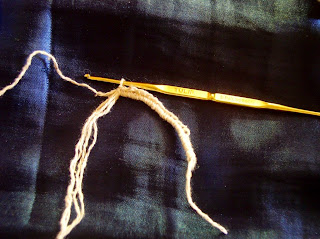This is what I do when I make a dress without a pattern. I hope that this inspires you to do the same. And more.
Corinthia is an exercise in making a crocheted dress without the use of patterns and with only very minimal shaping. A basic dress is finished first then it is embellished with Irish crochet motifs.
Corinthia is worked in the round. Work starts at the waist: a strip of motifs joined together. Then the upper section is made up to the armpits, crocheting in rows with decrease at the front to shape the overlapping V-neckline. The V-neckline then commences separately towards the left and right Front shoulder. The low back and shoulder for the Back is added on separately. The skirt section is worked down from the waist, in rounds. There is no shaping as the motifs already narrow at the waist, gathers a bit then flares very slightly as work is done downwards.
The upper part of the dress is worked in a trellis with picots stitch pattern. This is easy to shape. The lower part of the dress is worked in alternating rounds of sc, dc-ch-dc, dc, etc. – just to create an interesting mesh design.
MAKING THE BASIC DRESS
After the basic dress is finished, Irish crochet motifs are made and sewn onto the dress.
MAKING THE IRISH CROCHET MOTIFS
The hook I used for this project is 2.25mm and the yarn is 3-ply silk-acrylic and thicker 8-ply cotton yarn for the padding cord.
Some lessons:
Crochet dresses tend to stretch due to gravity. They stretch more with every washing and most specially when hang to dry. Stretch is prevented by drying flat and flat storage.
However, I tend to prefer hang dry because this allows the crochet fabric to dry faster. During the cooler and wet seasons, crochet fabric take longer to dry and have that unpleasant smell if they do not dry properly.
If you use a blocked gauge swatch, you can crochet the garment to a size approximating that of the washed finished garment taking into account stretch through washing and gravity. However, a blocked gauge can’t really account for gravity during wear.
So what I do is trial and error especially when using a yarn I am not familiar with. When I finish a basic garment (without the motifs), I try to make them shorter than the desired finished length. If the garment stretches after washing (and hanging to dry), I adjust the shoulder length. This is why I often leave tail ends undone until I am perfectly certain that the garment will no longer stretch.
Sewing a lining to the dress is another solution. The lining, especially when sewn at the seams, will keep the crochet fabric from stretching. I have not tried this before, though, so I have no experience to speak of of this solution.
Finishing stitches are also a solution. The finishing done along the neckline, armholes, and shoulders as well as the waist in some cases, provide the “back bone” for the dress. A good strong finishing/trim of solid tight stitches will have the least tendency to stretch.
Or – of course – you can use yarn that has the least tendency to stretch and change its shape due to gravity, washing or other. Cotton is one example I can think of. It has only a mild tendency to stretch.
One solution I have tried is to crochet the yarn together with polyester thread of matching colour, as polyester thread will not stretch.




















Comments
Post a Comment